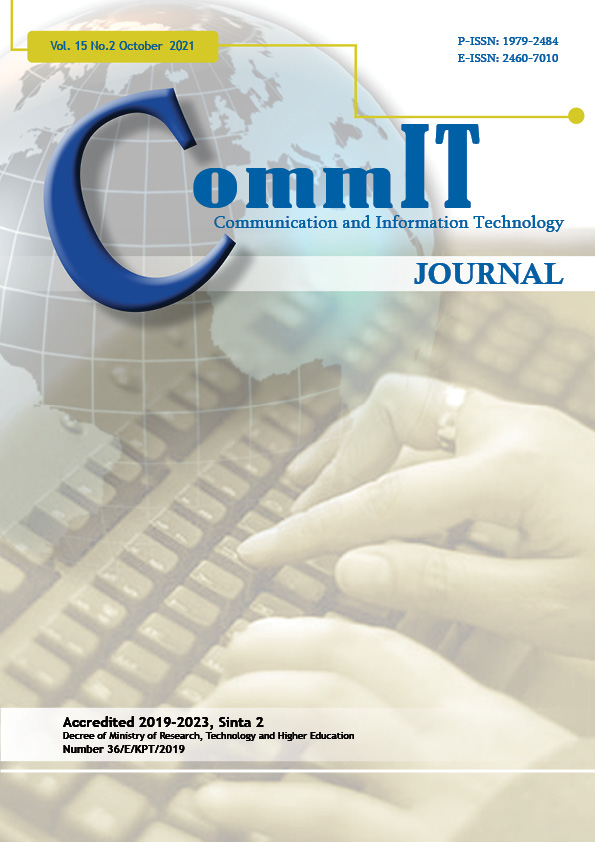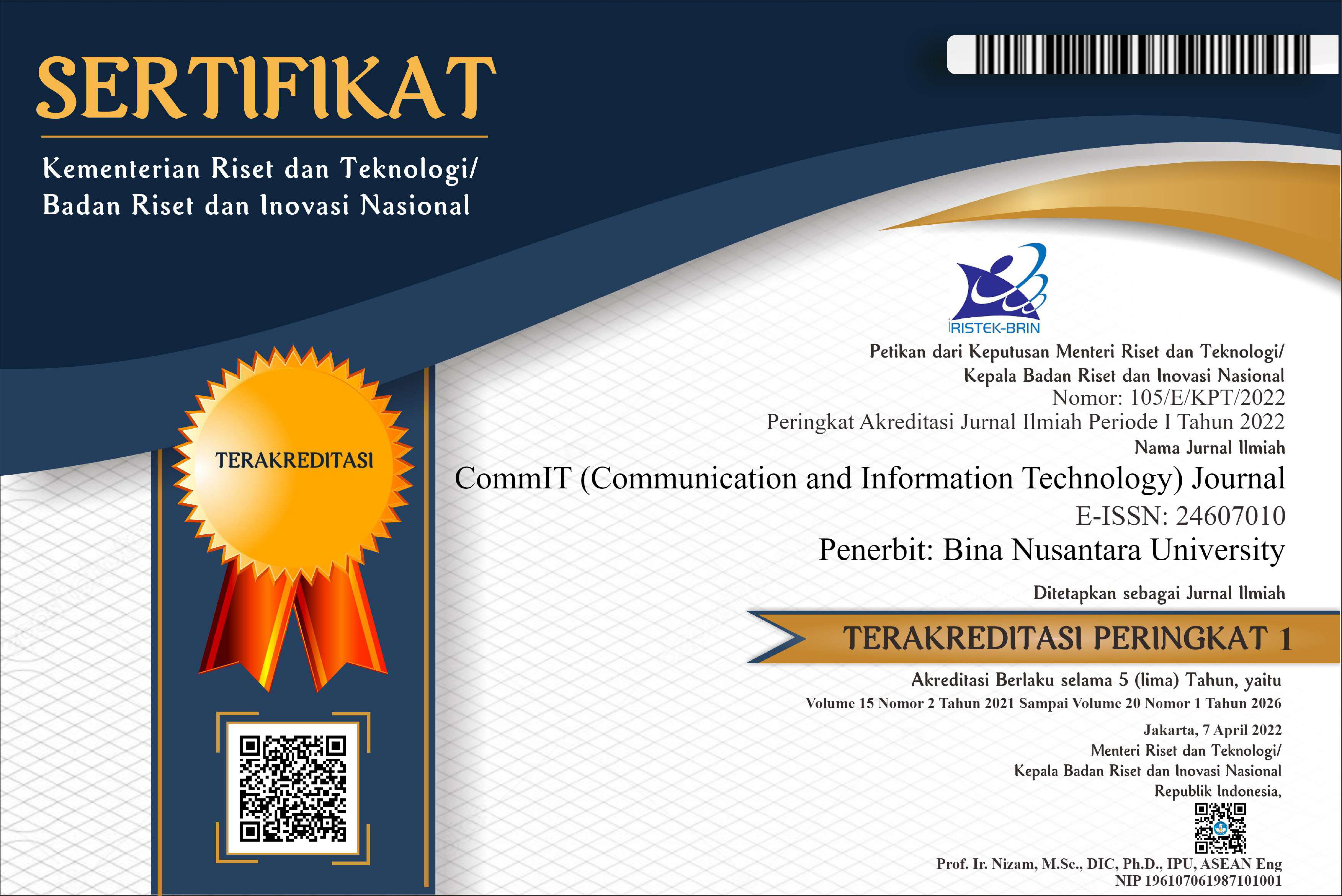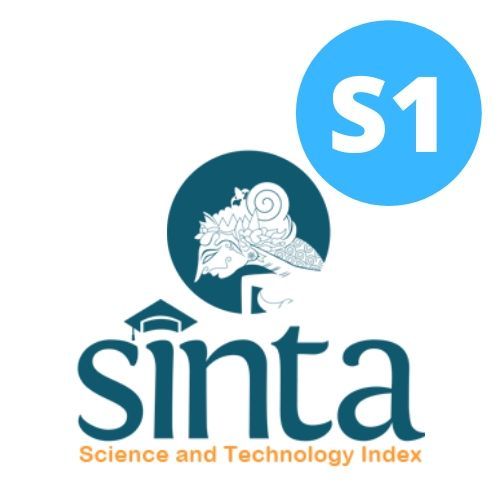Enhanced Financial Business Competitiveness by Leveraging Technology and Innovation
DOI:
https://doi.org/10.21512/commit.v15i2.6968Keywords:
Financial Business, Business Competitiveness, Financial Technology, Financial InnovationAbstract
The financial industry has developed rapidly with the emergence of financial technology companies. Moreover, the use of technology in the financial industry has developed rapidly. However, conventional financial companies face tough challenges in doing business. They have to adopt the technology to survive. The adoption of technology will increase the competitiveness of established financial companies against financial technology companies. The research aims to analyze the impact of technology on improving the work process of established financial companies. It examines the business model of established financial companies and financial technology companies. The work process is almost identical for all companies. The research applies a qualitative method. The chosen companies are multi-purpose financing for the purchase of two-wheeled and four-wheeled motorized vehicles. The total number of companies involved in the research is four companies. The result concludes that conventional consumer finance companies need to adopt technology into the work process to compete with financial technology companies. Technologies that can be used are Artificial Intelligence (AI), automation job allocation, chatbot, and face recognition. The work process is reviewed by digitizing, eliminating, and moving. Then, technology adoption will require a large investment. Hence, consumer finance companies can collaborate with technology companies, including financial technology companies.
Plum Analytics
References
S. Johan, “Performance and contribution of Japanese and non-Japanese financial institutions in developing economies: An empirical research in Indonesia,” JDM (Jurnal Dinamika Manajemen), vol. 11, no. 1, pp. 56–64, 2020.
——, “Analisis struktur industri pembiayaan Indonesia,”Jurnal Muara Ilmu Ekonomi dan Bisnis, vol. 1, no. 1, pp. 18–25, 2017.
Y. S. Cho and K. Linderman, “Metacognitionbased process improvement practices,” International Journal of Production Economics, vol. 211, pp. 132–144, 2019.
S. Johan, “Implementasi strategi bisnis dan korporasi melalui merger dan akuisisi,” Ultima Management: Jurnal Ilmu Manajemen, vol. 3, no. 1, pp. 68–81, 2011.
Y. H. Akbar and A. Tracogna, “The sharing economy and the future of the hotel industry: Transaction cost theory and platform economics,”International Journal of Hospitality Management, vol. 71, pp. 91–101, 2018.
Y. M. A. Amuna, S. S. Abu-Naser, M. J. Al Shobaki, and Y. A. A. Mostafa, “Fintech: Creative innovation for entrepreneurs,” International Journal of Academic Accounting, Finance and Management Research (IJAAFMR), vol. 3, no. 3, pp. 8–15, 2019.
M. P. Allmendinger and E. S. Berger, “Selecting corporate firms for collaborative innovation: Entrepreneurial decision making in asymmetric partnerships,” International Journal of Innovation Management, vol. 24, no. 01, pp. 2 050 003–1–2 050 003–2, 2020.
J. K. De Groote and J. Backmann, “Initiating open innovation collaborations between incumbents and startups: How can David and Goliath get along?” International Journal of Innovation Management, vol. 24, no. 02, pp. 2 050 011–1–2 050 011–33, 2020.
G. Rubera and A. H. Kirca, “You gotta serve somebody: The effects of firm innovation on customer satisfaction and firm value,” Journal of the Academy of Marketing Science, vol. 45, no. 5, pp. 741–761, 2017.
Otoritas Jasa Keuangan, “Statistik lembaga pembiayaan periode Desember 2020,” 2021. [Online]. Available: https://bit.ly/3xXsbU7
M. Ketokivi and J. T. Mahoney, “Transaction cost economics as a theory of supply chain efficiency,”Production and Operations Management, vol. 29, no. 4, pp. 1011–1031, 2020.
S. Johan, “Determinant efficiency of financial institutions in emerging market,” Jurnal Manajemen dan Pemasaran Jasa, vol. 12, no. 2, pp. 165–176, 2019.
S. Ahluwalia, R. V. Mahto, and M. Guerrero, “Blockchain technology and startup financing: A transaction cost economics perspective,” Technological Forecasting and Social Change, vol. 151, pp. 1–6, 2020.
S. Satyal, I. Weber, H. Y. Paik, C. Di Ciccio, and J. Mendling, “Business process improvement with the AB-BPM methodology,” Information Systems, vol. 84, pp. 283–298, 2019.
I. Taifa and T. Vhora, “Cycle time reduction for productivity improvement in the manufacturing industry,” Journal of Industrial Engineering and Management Studies, vol. 6, no. 2, pp. 147–164, 2019.
B. Macfarlane, “The paradox of collaboration: A moral continuum,” Higher Education Research & Development, vol. 36, no. 3, pp. 472–485, 2017.
V. Aggarwal and A. Wu, “Inter-organizational collaboration and start-up innovation,” in Entrepreneurship and collaboration, S. Matusik and J. Reuer, Eds. Oxford, UK: Oxford University Press. Forthcoming, 2018, pp. 1–26.
F. Mercandetti, C. Larbig, V. Tuozzo, and T. Steiner, “Innovation by collaboration between startups and SMEs in Switzerland,” Technology Innovation Management Review, vol. 7, no. 12, pp. 23–31, 2017.
L. Peter, A. Back, and T. Werro, “A taxonomic framework on prevalent collaborative innovation options between corporations and startups,” International Journal of Digital Technology & Economy, vol. 3, no. 2, pp. 63–94, 2018.
A. Gviniashvili, “Collaboration for innovation in the financial sector: A qualitative study of Norwegian FinTechs,” Master’s thesis, TIK Center for Technology, Innovation and Culture, Faculty of Social Sciences, University of Oslo, 2019.
V. Acharya and Z. Xu, “Financial dependence and innovation: The case of public versus private firms,” Journal of Financial Economics, vol. 124, no. 2, pp. 223–243, 2017.
S. Munir, G. J. Rangel, R. K. Subramaniam, and M. Z. Bin Mustapha, “Do heterogeneous boards promote firm innovation? Evidence from Malaysia,” Capital Markets Review, vol. 28, no. 1, pp. 25–47, 2020.
P. Ruggiero and S. Cupertino, “CSR strategic approach, financial resources and corporate social performance: The mediating effect of innovation,”Sustainability, vol. 10, no. 10, pp. 1–22, 2018.
J. Chi, J. Liao, and J. Yang, “Institutional stock ownership and firm innovation: Evidence from China,” Journal of Multinational Financial Management, vol. 50, pp. 44–57, 2019.
X. Xie, J. Huo, and H. Zou, “Green process innovation, green product innovation, and corporate financial performance: A content analysis method,” Journal of Business Research, vol. 101, pp. 697–706, 2019.
F. Ezzi and A. Jarboui, “Does innovation strategy affect financial, social and environmental performance?”Journal of Economics, Finance and Administrative Science, vol. 21, no. 40, pp. 14–24, 2016.
M. Abdu and A. Jibir, “Determinants of firms innovation in Nigeria,” Kasetsart Journal of Social Sciences, vol. 39, no. 3, pp. 448–456, 2018.
R. Lee, J. H. Lee, and T. C. Garrett, “Synergy effects of innovation on firm performance,” Journal of Business Research, vol. 99, pp. 507–515, 2019.
H. Luong, F. Moshirian, L. Nguyen, X. Tian, and B. Zhang, “How do foreign institutional investors enhance firm innovation?” Journal of Financial and Quantitative Analysis, vol. 52, no. 4, pp. 1449–1490, 2017.
J. Sierra, “How financial systems and firm strategy impact the choice of innovation funding,”European Journal of Innovation Management, vol. 23, no. 2, pp. 251–272, 2020.
C. X. Mao and J. Weathers, “Employee treatment and firm innovation,” Journal of Business Finance & Accounting, vol. 46, no. 7-8, pp. 977–1002, 2019.
A. Wadhwa, C. Phelps, and S. Kotha, “Corporate venture capital portfolios and firm innovation,”Journal of Business Venturing, vol. 31, no. 1, pp. 95–112, 2016.
P. Kijkasiwat and P. Phuensane, “Innovation and firm performance: The moderating and mediating roles of firm size and small and medium enterprise finance,” Journal of Risk and Financial Management, vol. 13, no. 5, pp. 1–15, 2020.
H. Lu, Y. Li, M. Chen, H. Kim, and S. Serikawa, “Brain intelligence: Go beyond artificial intelligence,”Mobile Networks and Applications, vol. 23, no. 2, pp. 368–375, 2018.
T. H. Davenport and R. Ronanki, “Artificial intelligence for the real world,” Harvard Business Review, vol. 96, no. 1, pp. 108–116, 2018.
L. D. Wall, “Some financial regulatory implications of artificial intelligence,” Journal of Economics and Business, vol. 100, pp. 55–63, 2018.
N. R. Mosteanu, “International financial markets face to face with artificial intelligence and digital era,” Theoretical & Applied Economics, vol. 26, no. 3, pp. 123–134, 2019.
D. Mhlanga, “Industry 4.0 in finance: The impact of Artificial Intelligence (AI) on digital financial inclusion,” International Journal of Financial Studies, vol. 8, no. 3, pp. 1–14, 2020.
H. K. Mohajan, “Qualitative research methodology in social sciences and related subjects,”Journal of Economic Development, Environment and People, vol. 7, no. 1, pp. 23–48, 2018.
J. Oh and I. Shong, “A case study on business model innovations using Blockchain: Focusing on financial institutions,” Asia Pacific Journal of Innovation and Entrepreneurship, vol. 11, no. 3, pp. 335–344, 2017.
M. Brydon-Miller, D. Greenwood, and P. Maguire, “Why action research?” Action Research, vol. 1, no. 1, pp. 9–28, 2003.
Downloads
Published
Issue
Section
License
Copyright (c) 2021 Suwinto Johan

This work is licensed under a Creative Commons Attribution-ShareAlike 4.0 International License.
Authors who publish with this journal agree to the following terms:
a. Authors retain copyright and grant the journal right of first publication with the work simultaneously licensed under a Creative Commons Attribution License - Share Alike that allows others to share the work with an acknowledgment of the work's authorship and initial publication in this journal.
b. Authors are able to enter into separate, additional contractual arrangements for the non-exclusive distribution of the journal's published version of the work (e.g., post it to an institutional repository or publish it in a book), with an acknowledgment of its initial publication in this journal.
c. Authors are permitted and encouraged to post their work online (e.g., in institutional repositories or on their website) prior to and during the submission process, as it can lead to productive exchanges, as well as earlier and greater citation of published work.
USER RIGHTS
All articles published Open Access will be immediately and permanently free for everyone to read and download. We are continuously working with our author communities to select the best choice of license options, currently being defined for this journal as follows: Creative Commons Attribution-Share Alike (CC BY-SA)




















